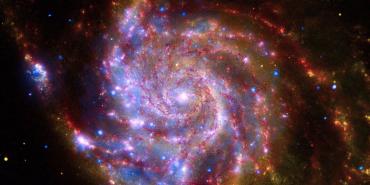Explore the Program
Each summer, the Space Telescope Science Institute (STScI) employs about a dozen highly motivated college students for the Space Astronomy Summer Program (SASP) to work individually with STScI researchers and staff on projects that include data reduction and interpretation, software development, software engineering, instrument calibration and support, scientific writing, and public outreach. STScI is a premier astronomical research institution, and our scientific staff of astronomers, scientists, analysts, and engineers is at the forefront of some of the most exciting astronomy going on today, including the study of our own solar system, the structure of the Milky Way, the composition of near and distant galaxies, and dark energy.
Our competitive program is primarily open to upper-division undergraduates with a strong interest in space-based astronomy, engineering, or public outreach (other candidates may be considered on an individual basis). In addition to hands-on projects, students are matched with a mentor and attend a variety of lectures. Students receive a stipend, housing assistance, and travel reimbursement.
We proudly partner with the National Astronomy Consortium (NAC) to provide research opportunities to women and underrepresented minorities in astronomy-enterprise areas, and other STEM fields.
2024 SASP
Program dates will be June 3 through August 2, 2024. Accepted interns will be brought to the STScI campus in Baltimore, Maryland, to work directly with their mentors. Scroll down for additional program details. The application window for the 2024 internship program is now closed.
Symposium
2023 SASP Symposium
As the culmination of the Space Astronomy Summer Program, students provided short presentations of their efforts followed by Q + A.
The 2023 Symposium was held August 3, 2023.
To expose undergraduates to leading research in astrophysics, and the workings of a space-based observatory.
Although not every student who comes to STScI is directly involved in an astronomical research project, all students may learn about the research and related support efforts conducted at STScI.
To provide participants with opportunities for growth, achievement, and personal development.
For many students, coming to STScI will be a more focused experience than they have had before. They will learn how our staff prepared for their roles through education and research, and how they initiate and carry out our major projects at the institute.
To place students in a cohort of friends and colleagues.
Astronomy is a human undertaking, and it remains a small profession. Developing and maintaining contacts among colleagues and peers may be vital for a successful career.
Types of Opportunities
Astrophysics Research Projects
Students will have the opportunity to contribute to our astronomers and scientists’ research through statistical analysis and physical interpretation of astronomical data, coding, or the application of other skills. Specific topics change year to year based on the selection of mentors, but may center on solar system objects, extrasolar planets, stars and stellar populations, galaxies and the intergalactic medium, cosmology, and black holes.
Software Engineering Projects
STScI staff members work with astronomers who use the space telescopes, and in calibrating and archiving their data for the Mikulski Archive for Space Telescopes (MAST), one of the first and biggest archives for astronomical data. Students may work with physicists and mechanical engineers on instrumentation and testing; software engineers and computer scientists on internal and external software tools; flight operations staff on the creation and testing of scripts to operate the science instruments onboard the telescopes; or scientists to analyze large volumes of data.
Instrument Calibration Projects
Students will be part of a team that prepares raw data from the Hubble or James Webb Space Telescopes for scientific analysis. Each scientific instrument (e.g., cameras and spectrographs) has a team of scientists, analysts, and engineers who calibrate and characterize the raw data from their instruments. Interns can gain a deep understanding of how instruments onboard a space telescope are operated and how to process the resulting data to enable precise scientific measurements.
Public Outreach Projects
STScI brings the science and wonder of NASA observatories (including the Hubble and James Webb space telescopes) to the world in the form of news, outreach, and informal education products. Public outreach roles include helping with image processing, science writing, astronomical artwork, video production; the development of citizen science projects, Google Sky, and iOS applications; and contributing to applications for the astronomical community.







